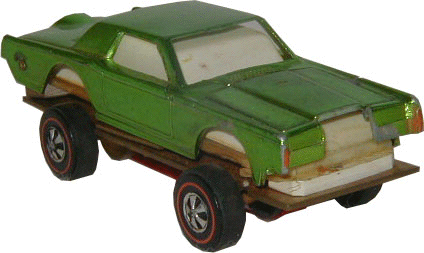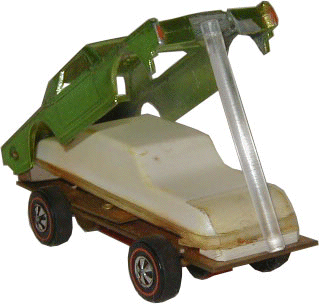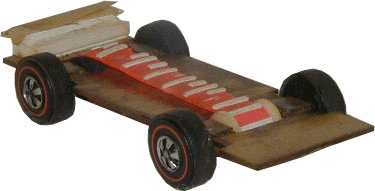The Noise-Making Lincoln Continental is one of the finest pieces in the collection. This one-of-a-kind model was designed by Derek Gable, a sixteen-year employee of Mattel. Gable, originally from England but living in the US since 1968, has great affection for his days as a Hot Wheels designer.
“It was a really truly unique experience, working at Mattel in those days made the movie ‘Big’ seem quite ordinary. The things that went on were bizarre. It was totally product driven. The guy who was the president of the company was a total toy man. It was a lot of fun and was all to do with the toys.” Gable was the head of the Mattel think-tank division, Preliminary Design, and supervised a staff of sixty. “The stuff I worked on was all imaginative. We didn’t do any of the nuts and bots, taking a regular car and copying it. My department was strictly to come up with original ideas. Basically, it was all new innovative stuff.” One of his most revolutionary designs was a “Noise-Making” Hot Wheels.

“At that particular time, in our department we were okay to work on anything that we wanted to, which was really kind of neat. The idea came from how can we make Hot Wheels cars have sound effects? What technologies do we have at our disposal at this time? And it was a mechanical sound, just like a Gramophone record, that was all that was really available.”
Gable, dabbling in all aspects of Mattel’s toy line, had worked on their talking doll, Randy Reader. “In the late sixties, we came up with an idea of a doll that played the equivalent of a record, but instead of a record, it played it with a needle, it was a tape, a plastic tape that was an endless loop that went onto a spool and came off the spool again, and then we put that into the doll. And it was battery-operated, and that allowed you to play a minute or two of conversation, which was a revolution at that time. I was thinking of what could you do with a Hot Wheels car to give it some sound, an engine sound, or maybe even a number of different sounds and this was prior to electronics or anything so I’m thinking you couldn’t very well put a record player in there. But then I was thinking about the Randy Reader doll, well, if you took the idea of having a record and straightened it out and put it on a band of plastic, you could play each of these grooves, and one could be an engine and one could be the horn and one could be the screeching tires, and there could be room in the chassis for a single band that could probably give you at least one second of play, so you could have a ‘vroom’ or ‘honk’ and if you played the same track it would go ‘vroom vroom vroom’ or ‘honk honk honk’”.

Gable looked at the current line-up of Hot Wheels and chose the Lincoln Continental primarily for its size. “It needed something that had a long wheelbase and it needed a relatively large body so you could get a decent-sized speaker in it.”
He constructed two models from existing cars and hand-crafted parts. “That model was my first attempt to see if it was going to fit in. What I was hoping to do was to have it so that the wheels would ‘free wheel’ just as a normal Hot Wheels car, until you pushed down on it, and when you pushed down on it, it would engage the belt and move it past a needle that would be on the top of a diaphragm like a speaker cone that would be in the roof of the car. You could use the car with any of the other race sets and it wouldn’t make any noise and it wouldn’t impair the operation of the car.” The prototype sound belt was designed to make a clacking noise as it passed the needle, just as members of a certain generation fixed baseball cards to the spokes of their bikes to mimic a motorized engine sound. “It was a very low-tech sort of deal.”

Unfortunately, budget concerns were insurmountable. “Like most of the things we did, they were experiments, they were too costly or they weren’t effective enough. The trouble was with Hot Wheels, and it still is really, the components that would have needed to be added to make those sound effects were going to probably double the price and that just became prohibitive. So, it was just shelved as an idea. It was moved forward through several stages, but never taken to production. It was just a preliminary model to test out the principles.”

And what happened to that prototype model? Gable laughs. “It was supposed to go into something we called ‘The Morgue’, put into a box, catalogued, then put away. That particular one, obviously it went into my pocket and came home with me, but it was supposed to go into the morgue, which was like a burial ground of ideas that didn’t make it.”
While it’s a shame the idea of the noise-making Hot Wheels never came to fruition, it’s a blessing that it didn’t stay buried.